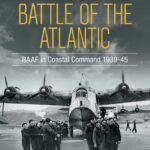
Group biography, airport architecture, and a campaign history. (If it wasn’t obvious by now, I’m selecting these books completely at random!)
Kristen Alexander, Australia’s Few and the Battle of Britain (Sydney: NewSouth Publishing, 2014). Despite Kristen being a friend, I’m ashamed to say that I’ve never read any of her books before — doubly unfortunate, because this one is excellent. It’s not a comprehensive history of Australian pilots in the Battle (which would be hard to do: as Kristen notes, various authorities give a total of anywhere between 21 and 37) but rather biographies of eight of them, interwoven in a narrative of their lives before joining up, training, first operations and the Battle itself (about half the book). I was particularly interested to note that most of these men were first very airminded boys (Des Sheen, for example, was inspired by seeing Bert Hinkler, Amy Johnson and especially Jean Batten on their flying visits to Canberra), though of course there’s a selection effect here (not only hindsight, but an Australian basically would have to be keen to get themselves into the RAF so early in the war). It’s not just flying, though. Kristen pays full attention to the pilots’ families (especially since letters are a key source) back home as well as their personal lives, which is especially moving because — fair warning — most of these very young men do not survive until the end of the book. Indeed, while the many characters can be a bit hard to keep track of at the start, it’s sadly a lot easier by October 1940 when the few have become very few indeed.
Terry Moyle, Art Deco Airports: Dream Designs of the 1920s & 1930s (London: New Holland, 2015). This is a gorgeously illustrated book, filled not only with many large and small photos of interwar airports and their aircraft, but also lovely, often full-page, vector illustrations by Rosie Louise. In his introductory essay (which could serve as a useful primer on the culture of airmindedness) Moyle is clear that the ‘Art Deco’ of the title is more about the period than architecture, and certainly there was a wider variety of styles in use than I’d understood (Spanish Mission! Adobe Revival!) He identifies Le Bourget as, if not the prototype, then the exemplar of the basic two-storied admin building to be found across so many airports, especially in the United States (which accounts for about two-thirds of the airports in this book). As well as the architecture and the decor, Moyle pays considerable attention to the airliners themselves (making a good case for the importance of the Farman Goliath, as well as the inspiration for Le Bourget’s terminal!); less so for navigational aids and suchlike. Most interesting of all, for me anyway, were the details about the passenger facilities such as restaurants and waiting rooms, and especially the widespread provision for crowds of spectators: Grand Central Airport in Glendale, California, for example had more than 250,000 visitors in the first six months of 1930 (compared with 25,608 passengers) — with average crowds of between 10,000 and 25,000 on weekends. I do have to register some criticisms. The wonderful photos would have more value for me as a researcher if more information was provided about their provenance (at least a year, if not a source, would be nice; these are often missing). And while the physical presentation of this book is outstanding, the editing is less so (there are a couple of dozen ‘it’s’ when ‘its’ was meant, for example). But as a coffee table book, it’s terrific.
Barrett Tillman, Whirlwind: The Air War against Japan, 1942-1945 (New York: Simon & Schuster Paperbacks, 2010). This is a panoramic account of the Allied air raids on Japan (not the entire air war, as you might surmise from the title) in the Second World War. Tillman covers a lot of ground, from prewar theorising (the usual trinity of Douhet, Trenchard and Mitchell) through to Japanese ARP, the British Pacific Fleet and the atomic bombs. There’s some strategy, more operations, accounts by American servicemen, Japanese pilots and civilians too (which I was pleasantly surprised to see). Tillman is a highly experienced author in aviation history and he draws on a lot of his own interviews with US airmen, particularly, but he’s also cited a number of websites and forums for his primary source material. The secondary sources are rather dated, too, many of them from the 1980s or earlier. As an overview or introduction, though, it’s largely sensible and serviceable, especially if you can get over the occasionally purple prose (though you have to admire an author who can use the word ‘aborning’ (15) with a straight face!)
![]() This work is licensed under a Creative Commons Attribution-NonCommercial-NoDerivatives 4.0 International License.
Permissions beyond the scope of this license may be available at http://airminded.org/copyright/.
This work is licensed under a Creative Commons Attribution-NonCommercial-NoDerivatives 4.0 International License.
Permissions beyond the scope of this license may be available at http://airminded.org/copyright/.



